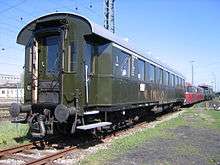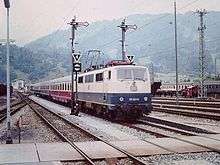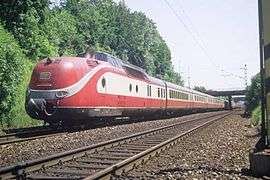Karwendel (train)
|
VT 11.5 in DB Touristik livery, Munich (1986) | |
| Overview | |
|---|---|
| Service type | |
| Locale |
|
| First service | 1930 |
| Current operator(s) | Deutsche Bahn |
| Former operator(s) | |
| Route | |
| Start | Berlin-Gesundbrunnen |
| Stops | Halle (Saale), Jena Paradies, Nuremberg, Munich |
| End | Innsbruck/Seefeld in Tirol |
| Train number(s) | ICE 1206/1207 |
| Line used | Karwendelbahn |
| Technical | |
| Rolling stock |
|
| Track gauge | 1,435 mm (4 ft 8 1⁄2 in) |
| Electrification | 15 kV AC |
The Karwendel is an international named express train service between Germany and Austria. The train was named after the Karwendel mountain range forming the German-Austrian border south of Garmisch-Partenkirchen, which it passes on the Mittenwald Railway (Karwendelbahn). Introduced in 1930, it is currently labelled as an Intercity-Express train connection operated by Deutsche Bahn AG.
History

Since the opening of the Mittenwald Railway line in 1912, train service was provided to reach the tourist resorts in the Karwendel range such as Mittenwald and Seefeld in Tirol. First D-Zug express trains ran from 1925 onwards on the electrified Munich–Garmisch-Partenkirchen railway. In 1930 the Deutsche Reichsbahn introduced the Karwendel-Express, linking Munich with Innsbruck via the scenic Karwendelbahn route through the mountains with the border crossing at Mittenwald. Special passenger cars were built, calling at the 1936 Winter Olympics venues in Garmisch-Partenkirchen. The operation ceased in World War II.
After the war, D-Zug service continued from Munich to Seefeld and Innsbruck. In 1969 the Deutsche Bundesbahn reintroduced the Ft Karwendel train using VT 11.5 TEE diesel multiple units.[1] The Saturday only train was classified as package tour touristtrain serving several wintersport resorts along the Karwendelbahn between Garmisch and Seefeld. The service started in Frankfurt am Main, much farther north then the pre-war start at Munich.[2] From the introduction of the Intercity system in 1971 the train was named ICt Karwendel.[3]

In May 1979 a daily Intercity service from Bremen to Innsbruck named IC Karwendel has been introduced,[3] hauled by DB Class 103 and 111 electric locomotives. On 31 May 1987 it was one of the initial EuroCity services.[4] The EuroCity started as far north as Hamburg but its initial southern terminus Innsbruck was already changed to Seefeld by September 1987 and after only one year as EuroCity the train was reconverted into an Intercity.[5]
Since 2008 the Karwendel has been an ICE service using ICE T (DB Class 411) high-speed electric multiple units, with Berlin the northern terminus and serving the region south of Munich only at weekends.[6]
References
- ↑ Reisen 1.Klasse page 93
- ↑ Timetables of FDt Karwendel 1969 and 1970 at www.welt-der-modelleisenbahn.com
- 1 2 Timetables of IC Karwendel from 1971 to 1984 at www.welt-der-modelleisenbahn.com
- ↑ Deutsche Bahn, timetable Ihr Zugbegleiter 1987, shown at www.grahnert.de
- ↑ "EuroCity-Net Gewijzigd". De Kampioen (in Dutch). The Royal Dutch Touring Club (ANWB): 61. July–August 1988. Retrieved 26 March 2013.
- ↑ Current DB-timetable, kursbuch.bahn.de, table (Kursbuchstreckennummer) 960
Works cited
- Berndt, Torsten (2002). Reisen 1. Klasse VT 11.5 (in German). Irsee: Märklin.
